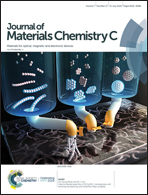A flexible viscoelastic coupling cable with self-adapted electrical properties and anti-impact performance toward shapeable electronic devices†
Abstract
A novel flexible cable with self-adapted electrical conductivity and anti-impact characteristics has been developed by combining the elastic PDMS shell and the viscous CNTs/STG (shear-thickening gel) string. Excitingly, the conductivity of the cable can return to the initial state while the deformation of the sensor is still maintained. Therefore, the cable exhibits rare dynamic sensitivity, which can be applied on various targets with uneven surfaces. This flexible cable shows high stretch fracture strain (151%) and its resistance is linearly dependent on the stretch strain and bending angle. The gauge factor of the cable is 1.18, which endows it with an ability to trace joints of the human body while walking, jumping and squatting. More importantly, due to the energy dissipation nature of the STG, the cable shows excellent anti-impact performance by buffering 70.5% of the impact energy and detecting high energy stimuli. An elastic-viscous combining mechanism has been proposed to discuss the mechanic–electric coupling performance, and the creep of viscous STG string plays a key role in determining the self-adapted conductivity. Because of the self-adjusting electric property, anti-impact performance, and sensing behavior, this cable can be further attached to the Kevlar fabric to form a wearable electric device to measure the distribution of pressure.



 Please wait while we load your content...
Please wait while we load your content...